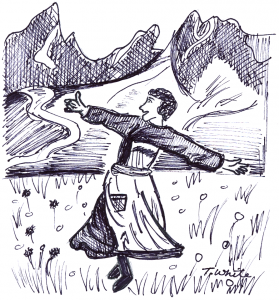Growing up, I often watched Turner Classic Movies, where big-budget musicals from the 1960s, such as Camelot, Hello Dolly!, Oliver! and Chitty-Chitty Bang-Bang would air frequently. Movies such as these all feature an overture, intermission and entr’acte, as if they are actually being performed onstage. Biographer Matthew Kennedy studies this type of lavish “roadshow movie” in his new book, “Roadshow! The Fall of Film Musicals in the 1960s.” For the most part, Kennedy succeeds in melding a gossipy, journalistic tone with a thorough historical analysis of the epic film musicals that nearly destroyed Hollywood.
By 1960, the movie musical, like the classic Broadway musical, was running out of fresh ideas. There was a brief respite from banality in 1964-65 when roadshow musical films like “Mary Poppins,” “My Fair Lady” and “The Sound of Music” became gargantuan hits, despite garnering mixed critical reception. Each film had an overture, intermission, and entr’acte. Tickets were sold in advance and playbills were distributed at each screening. Emboldened by the success of such lavish films, old-time Hollywood executives such as Jack Warner and Daryl Zanuck approved roughly two-dozen roadshow musicals, expecting that they would become huge hits.
Unfortunately, the roadshows that premiered from 1966 to 1972 mostly flopped at the box office. As the public’s tastes shifted toward more radical films like “Easy Rider” and “Bonnie & Clyde,” there was little demand for a cheesy, unchallenging, family-oriented spectacle like “Hello Dolly!” The roadshow musicals also suffered from behind-the-scenes disasters. “Doctor Doolittle,” “Hello Dolly!” and “Half-a-Sixpence” were sabotaged by miscasting. Julie Andrews’ “Star!” was too long and too dull. “The Happiest Millionaire” and “Finian’s Rainbow” lacked cohesion. “Camelot” was campy. “Chitty-Chitty Bang-Bang” was a Mary Poppins clone. “Paint Your Wagon” and “Song of Norway” were just stupendously, egregiously bad. Even “How to Succeed in Business Without Really Trying,” “Oliver!” and “Funny Lady,” while they hold up well today, drag in places.
It is astonishing to read about how major film studios, which weathered two world wars and the downfall of silent film, threw tens of millions of dollars away on subpar movies. It is equally astonishing to read about the cultural tone deafness of longtime Hollywood and industry executives, who failed to grasp that the public no longer wanted old-fashioned movies, let alone old-fashioned roadshow musicals. Still, filmmakers and CEOs were slow to recognize this fact, leading to one box office dud after another, hostile takeovers of studios, lawsuits, and the near-destruction of MGM.
Kennedy writes with a fast pace, describing the egos, economics and changing morals of Hollywood in the 1960s. Despite “Roadshow!”’s sometimes-gossipy tone, the book features a substantial amount of primary source citations and quotes many movie reviews from the 1960s, helping place the reader in the 60s cultural scene. Kennedy also makes a compelling case that the corporate takeover of Hollywood, which came after roadshows bankrupted the major studios, made American musicals far less adventurous. Still, Kennedy occasionally gets carried away with bashing the roadshow musicals of the 60s. At times, it seems like he has a personal grudge against these movies for not being better. He could have been more restrained in his language when reviewing the films, or let the quoted newspaper articles speak for themselves. Additionally, Kennedy finds fault with basically every movie musical made after 1960, but never really defines what a perfect movie musical might look like.
The book also stubs its toe when describing America’s cultural history. Kennedy makes it clear that the public’s taste changed drastically from 1964 – the year “Mary Poppins” swept the box office – and 1970 – when “Song of Norway” killed off the roadshow musical. Obviously, people wanted to see more challenging movies. However, it is important to remember that, as society and movies liberalized ,there was cultural backlash – Richard Nixon won two landslide elections during this time period. In other words, there was a desire for the old-fashioned in culture, but Kennedy makes it seem as though all old-fashioned things, not only roadshow musicals, were rejected at once. Kennedy should have discussed this contradiction – how Americans wanted sex and violence on the big screen but simultaneously voted the status quo-maintaining Republican Party into power – in greater detail.
This book’s topic is a niche one, so we are unlikely to see a subsequent scholarly analysis of the toxic effects of roadshow musical films anytime soon. Overall, Kennedy succeeds in presenting an era of Hollywood excess in vivid detail, even if he inadequately explains its historical context and sometimes gets carried away with bashing box office turkeys. If nothing else, the stories of Barbra Streisand and Rex Harrison’s raging egos, Julie Andrews’ overhyped career, Peter O’Toole’s nonexistent singing voice and the lawyers who overthrew Jack Warner make for salacious and uproarious reading.
“Roadshow!” is recommended for economists, history buffs and musical lovers alike.
Gorman is a member of
the class of 2014.




